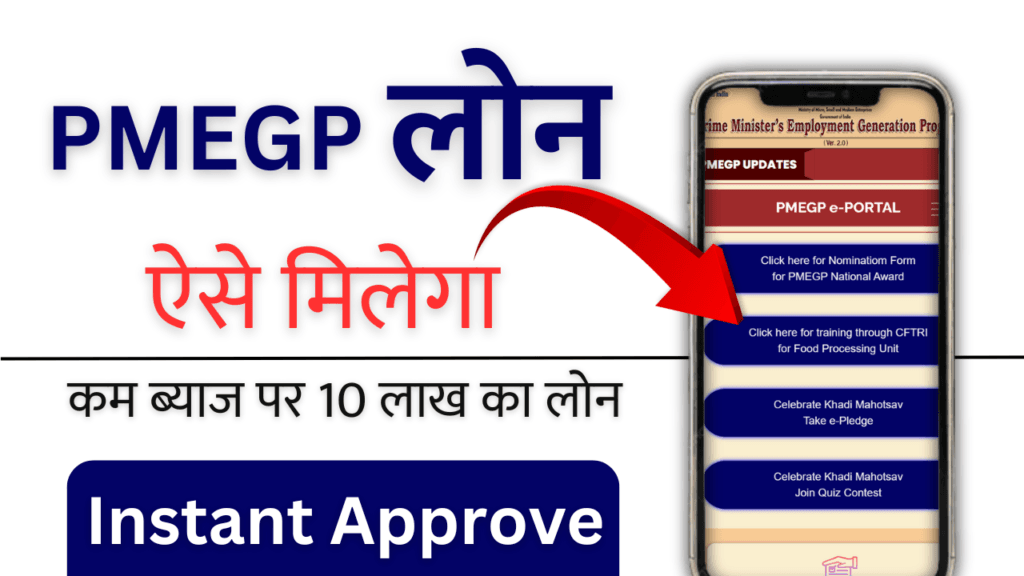Starting a business can be a daunting task, especially when finances are limited. That’s where government initiatives like the Prime Minister’s Employment Generation Programme (PMEGP) step in to support budding entrepreneurs. PMEGP is a flagship scheme of the Indian government designed to promote self-employment and generate jobs in rural and urban areas. Under this scheme, eligible individuals and institutions can avail of financial assistance to start new ventures.

In this article, we’ll discuss everything of the PMEGP Loan 2025, including eligibility criteria, loan limits, application procedures, important dates, and more. By the end, you’ll have all the necessary information to decide if this scheme is right for you.
What is the PMEGP Loan 2025?
The PMEGP Loan 2025 is a government-backed credit-linked subsidy scheme aimed at encouraging micro, small, and medium enterprises (MSMEs). Launched by the Ministry of Micro, Small, and Medium Enterprises (MSME), this scheme is implemented by the Khadi and Village Industries Commission (KVIC) at the national level. It helps individuals and small businesses access financial support to establish new enterprises, thereby boosting employment opportunities.
The PMEGP loan includes a subsidy component, making it easier for entrepreneurs to manage their repayment burden while focusing on business growth.
Key Highlights of PMEGP Loan 2025
| Scheme Name | PMEGP (Prime Minister’s Employment Generation Programme) |
| Launch Year | 2008 (Updated yearly, including 2025 guidelines) |
| Objective | To promote self-employment and entrepreneurship |
| Implementing Agency | KVIC (National Level), State KVIBs, DICs |
| Eligible Sectors | Manufacturing, Service, and Agro-Based Projects |
| Loan Amount | Up to ₹50 lakh (manufacturing), ₹20 lakh (services) |
| Subsidy | 15%–35% based on region and category |
| Application Process | Online through the PMEGP e-portal (www.kviconline.gov.in) |
What is the primary goal of the PMEGP Loan?
The PMEGP Loan aims to achieve the following:
- Promote Entrepreneurship: Encourage individuals to start their own ventures and become self-reliant.
- Generate Employment: Create sustainable jobs, especially in rural and semi-urban areas.
- Boost MSMEs: Support the growth of micro and small enterprises in manufacturing, service, and agro-based industries.
- Reduce Urban Migration: Provide employment opportunities in rural areas to reduce the migration of people to cities.
यह भी पढ़ें
Google Pay से ₹8 लाख तक का पर्सनल लोन: मिनटों में करें ऑनलाइन आवेदन!
Eligibility Criteria to get PMEGP Loan in 2025
Before applying for the PMEGP Loan, ensure you meet the following eligibility criteria:
1. Individual Applicants:
- Must be at least 18 years old.
- Should have passed at least 8th standard for projects above ₹10 lakh (manufacturing) and ₹5 lakh (services).
2. Institutions:
- Self-Help Groups (SHGs), cooperative societies, and charitable trusts are eligible.
3. Business Types:
- Only new businesses are eligible. Existing units are not covered.
4. Excluded Sectors:
- Businesses involved in banned or harmful activities, such as tobacco or alcohol production, are not eligible.
Loan Amount and Subsidy
The amount of loan and subsidy varies depending on the business type, location, and applicant category.
| Category | Urban Area Subsidy | Rural Area Subsidy |
|---|---|---|
| General Category | 15% | 25% |
| Special Category (SC/ST, OBC, Women, etc.) | 25% | 35% |
- Maximum Loan Amount:
- ₹50 lakh for manufacturing units.
- ₹20 lakh for service units.
- The remaining project cost is financed by banks as term loans.
How to Apply for PMEGP Loan 2025?
The application process for PMEGP Loan 2025 is entirely online, making it accessible and hassle-free. Follow these steps:
- Visit the Official Portal:
Go to the official PMEGP portal (www.kviconline.gov.in). - Register Yourself:
Create an account by providing your email ID and mobile number. - Fill Out the Application Form:
Enter personal details, project information, and upload the required documents. - Submit the Application:
Review your application and submit it online. You will receive an acknowledgment receipt with your application ID. - Screening and Approval:
Your application will be screened by the District Task Force Committee (DTFC) and forwarded to the concerned bank for loan approval.
List of Required Documents
To complete your application, ensure you have the following documents ready:
- Aadhaar Card or any government-issued ID
- Proof of Address (Electricity Bill, Ration Card, etc.)
- Project Report detailing the business plan
- Caste Certificate (for special categories)
- Educational Qualification Certificates
- Bank Passbook and recent photographs
Important Dates for PMEGP Loan 2025
While specific dates for 2025 may vary, the following timeline typically applies:
- Application Start Date: January 2025
- Application Deadline: March 2025 (may extend based on announcements)
- Approval Process: April–June 2025
- Disbursement of Funds: From July 2025 onwards
For updates, regularly check the PMEGP e-portal or contact the nearest KVIC office.
Benefits of PMEGP Loan
The PMEGP Loan offers several benefits to entrepreneurs:
- Financial Support: Provides substantial financial assistance for starting new businesses.
- Easy Accessibility: Online application and minimal paperwork make the process straightforward.
- Government Subsidy: Reduces the repayment burden with a subsidy of up to 35%.
- Inclusive: Encourages participation from women, SC/ST, and other disadvantaged groups.
- Promotes Local Businesses: Supports traditional crafts and rural industries.
FAQs
No, this scheme is strictly for new business ventures.
The subsidy ranges from 15% to 35%, depending on your category and business location.
Yes, businesses involved in activities like alcohol or tobacco production are not eligible.
It typically takes 2–3 months from the date of application, subject to the verification process.
No collateral is required for loans up to ₹10 lakh, as per government norms.

Deepak Verma is a graduate from Delhi University with a First Division. With 8 years of teaching experience in Mathematics and Science, he has mentored secondary and senior secondary students. Currently, he is an author at SAMSA, where he applies his expertise to create engaging educational content.


